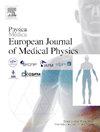Revisiting artifact spread function evaluation in digital breast tomosynthesis systems
IF 3.3
3区 医学
Q1 RADIOLOGY, NUCLEAR MEDICINE & MEDICAL IMAGING
Physica Medica-European Journal of Medical Physics
Pub Date : 2025-04-24
DOI:10.1016/j.ejmp.2025.104982
引用次数: 0
Abstract
Background
Digital Breast Tomosynthesis (DBT) has proved to be a powerful tool in breast cancer detection. However, the presence of zipper artifacts poses challenges in accurate diagnosis and there is not global methodology to evaluate its effects.
Purpose
The purpose of this study is to determine the most suitable method to characterize zipper artifact using the Full Width at Half Maximum (FWHM) of the Artifact Spread Function (ASF) as figure of merit and the adequacy Al sphere phantom as zipper artifact generators.
Methods
The study compares the zipper artifact on General Electric Senographe Pristine (SP-GE) and Hologic Selenia Dimensions (SD-HO) by calculating ASF in three different ways: maximum value method, mean value method and a hybrid method proposed by the authors.
Besides, the ASF generated by 1 mm aluminum sphere phantom was compared to those generated by 1 mm lead and tungsten markers, 2.3 mm ceramic markers and Mammo 156TM Phantom from Gammex.
Results
For the SP-GE system, the ASF calculated with the hybrid method resulted the most suitable approach in terms of reliability. In contrast, for the SD-HO system, the mean value method aligns better with system characteristics. The study underscores the importance of considering system-specific nuances in methodology selection for artifact evaluation. The data indicates that, for most of the methods, ceramic and lead (Pb) markers replicates better the artifacts observed in clinical practice.
Conclusions
The article emphasizes the need for standardized methodologies that can accommodate system-specific differences while ensuring accurate artifact assessment.

数字乳房断层合成系统中伪影传播函数评估的再探讨
数字乳腺断层合成(DBT)已被证明是乳腺癌检测的有力工具。然而,拉链伪影的存在对准确诊断提出了挑战,并且没有全面的方法来评估其影响。本研究的目的是确定最合适的方法来表征拉链伪影,使用伪影传播函数(ASF)的半最大值全宽度(FWHM)作为优点图,并将充分性Al球伪影作为拉链伪影发生器。方法采用最大值法、平均值法和作者提出的一种混合方法计算拉链的ASF,比较通用电气senograph Pristine (SP-GE)和Hologic Selenia Dimensions (SD-HO)上的拉链伪影。并将1mm铝球模体产生的ASF与1mm铅钨标记、2.3 mm陶瓷标记和Gammex公司的mamo 156TM模体产生的ASF进行比较。结果对于SP-GE系统,用混合方法计算的ASF在可靠性方面是最合适的方法。相比之下,对于SD-HO系统,均值法更符合系统特性。该研究强调了在工件评估的方法选择中考虑系统特定的细微差别的重要性。数据表明,对于大多数方法,陶瓷和铅(Pb)标记物可以更好地复制临床实践中观察到的伪影。这篇文章强调了标准化方法的需要,这种方法可以在确保准确的工件评估的同时适应系统特定的差异。
本文章由计算机程序翻译,如有差异,请以英文原文为准。
求助全文
约1分钟内获得全文
求助全文
来源期刊
CiteScore
6.80
自引率
14.70%
发文量
493
审稿时长
78 days
期刊介绍:
Physica Medica, European Journal of Medical Physics, publishing with Elsevier from 2007, provides an international forum for research and reviews on the following main topics:
Medical Imaging
Radiation Therapy
Radiation Protection
Measuring Systems and Signal Processing
Education and training in Medical Physics
Professional issues in Medical Physics.

 求助内容:
求助内容: 应助结果提醒方式:
应助结果提醒方式:


